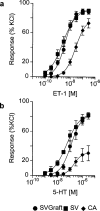Endothelin receptor expression and pharmacology in human saphenous vein graft
- PMID: 10077237
- PMCID: PMC1565828
- DOI: 10.1038/sj.bjp.0702326
Endothelin receptor expression and pharmacology in human saphenous vein graft
Abstract
1. We have investigated the expression and pharmacology of endothelin (ET) receptors in human aortocoronary saphenous vein grafts. 2. Subtype-selective ligands were used to autoradiographically identify ET(A) ([125I]-PD151242) and ET(B)([125I]-BQ3020) receptors. In graft saphenous vein ETA receptors predominated in the media, with few ET(B) receptors identified. Neither subtype was detected in the thickened neointima. 3. The ratio of medial ET(A):ET(B) receptors was 75%: 25% in both graft and control saphenous vein. 4. ET-1 contracted control (EC50 2.9 nM) and graft (EC50 4.5 nM) saphenous vein more potently than diseased coronary artery (EC50 25.5 nM). 5. In all three blood vessels ET-1 was 100 times more potent than ET-3 and three times more potent than sarafotoxin 6b (S6b). Little or no response was obtained in any vessel with the ET(B) agonist sarafotoxin 6c (S6c). 6. The ET(A) antagonist PD156707 (100 nM) blocked ET-1 responses in all three vessels with pKb values of approximately 8.0. 7. For individual graft veins the EC50 value for ET-1 and 'age' of graft in years showed a significant negative correlation. 8. In conclusion there is no alteration in ET receptor expression in the media of saphenous veins grafted into the coronary circulation compared to control veins. ETA receptors predominantly mediate the vasoconstrictor response to ET-1 in graft vein, with no apparent up-regulation of ET(B) receptors. The sensitivity of the graft vein to ET-1 increased with graft 'age', suggesting that these vessels may be particularly vulnerable to the increased plasma ET levels that are detected in patients with cardiovascular disease.
Figures





Similar articles
-
Endothelin receptor subtypes and their functional relevance in human small coronary arteries.Br J Pharmacol. 1998 Jun;124(3):499-506. doi: 10.1038/sj.bjp.0701865. Br J Pharmacol. 1998. PMID: 9647474 Free PMC article.
-
ETA receptor-mediated constrictor responses to endothelin peptides in human blood vessels in vitro.Br J Pharmacol. 1995 May;115(1):191-7. doi: 10.1111/j.1476-5381.1995.tb16338.x. Br J Pharmacol. 1995. PMID: 7647976 Free PMC article.
-
Vasoconstrictor endothelin receptors characterized in human renal artery and vein in vitro.Br J Pharmacol. 1994 Sep;113(1):49-54. doi: 10.1111/j.1476-5381.1994.tb16172.x. Br J Pharmacol. 1994. PMID: 7812631 Free PMC article.
-
The endothelin system in human saphenous vein graft disease.Curr Opin Pharmacol. 2001 Apr;1(2):176-82. doi: 10.1016/s1471-4892(01)00026-1. Curr Opin Pharmacol. 2001. PMID: 11714093 Review.
-
Endothelin-1 (ET-1) and vein graft failure and the therapeutic potential of ET-1 receptor antagonists.Pharmacol Res. 2011 Jun;63(6):483-9. doi: 10.1016/j.phrs.2010.10.018. Epub 2010 Nov 5. Pharmacol Res. 2011. PMID: 21056670 Review.
Cited by
-
Thromboxane receptor density is increased in human cardiovascular disease with evidence for inhibition at therapeutic concentrations by the AT(1) receptor antagonist losartan.Br J Pharmacol. 2001 Dec;134(7):1385-92. doi: 10.1038/sj.bjp.0704416. Br J Pharmacol. 2001. PMID: 11724743 Free PMC article.
-
Endothelin.Pharmacol Rev. 2016 Apr;68(2):357-418. doi: 10.1124/pr.115.011833. Pharmacol Rev. 2016. PMID: 26956245 Free PMC article. Review.
-
Involvement of 3',5'-cyclic inosine monophosphate in cystathionine γ-lyase-dependent regulation of the vascular tone.Br J Pharmacol. 2021 Sep;178(18):3765-3782. doi: 10.1111/bph.15516. Epub 2021 Jun 11. Br J Pharmacol. 2021. PMID: 33931865 Free PMC article.
-
Targeting endothelin signaling in podocyte injury and diabetic nephropathy-diabetic kidney disease.J Nephrol. 2025 Jan;38(1):49-60. doi: 10.1007/s40620-024-02072-w. Epub 2024 Sep 20. J Nephrol. 2025. PMID: 39302622 Review.
-
[125I-His(9)]-ghrelin, a novel radioligand for localizing GHS orphan receptors in human and rat tissue: up-regulation of receptors with athersclerosis.Br J Pharmacol. 2001 Sep;134(1):143-9. doi: 10.1038/sj.bjp.0704228. Br J Pharmacol. 2001. PMID: 11522606 Free PMC article.
References
-
- AKAR F., UYDES B.S., AYRANCIOGLU K., YENER A., ASLAMACI S., ARSAN M., TÖRÜNER A., KANZIK I. Endothelial function of human gastroepiploic artery in comparison with saphenous vein. Cardiovasc. Res. 1994;28:500–504. - PubMed
-
- ALBERTS G.F., PEIFLEY K.A., JOHNS A., KLEHA J.F., WINKLES J.A. Constitutive endothelin-1 overexpression promotes smooth muscle cell proliferation via an external autocrine loop. J. Biol. Chem. 1994;269:10112–10118. - PubMed
-
- ATKINSON J.B., FORMAN M.B., VAUGHN W.K., ROBINOWITZ M., MCALLISTER H.A., VIRMANI R. Morphologic changes in long term saphenous vein bypass grafts. Chest. 1985;88:341–348. - PubMed
-
- BACON C.R., CARY N.R.B., DAVENPORT A.P. Endothelin peptide and receptors in human atherosclerotic coronary artery and aorta. Circ. Res. 1996;79:794–801. - PubMed
-
- BATTISTINI B., CHAILLER P., D'ORLÉANS-JUSTE P., BRIÈRE N., SIROIS P. Growth regulatory properties of endothelins. Peptides. 1993;14:385–399. - PubMed
Publication types
MeSH terms
Substances
LinkOut - more resources
Full Text Sources
Miscellaneous

